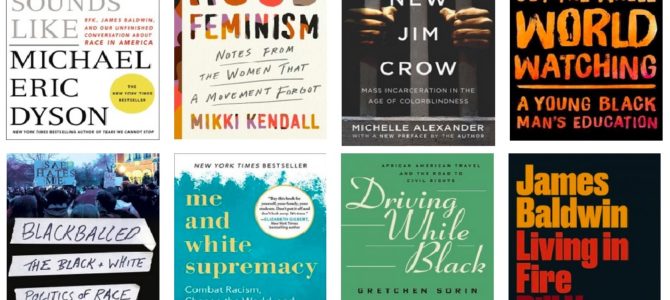
As he watched Joseph Stalin’s coffin removed from Red Square in 1961, Yevgeny Yevtushenko asked, “But how to remove Stalin from Stalin’s heirs.” For us, in 2020 the question becomes: “How to remove racism from the anti-racists?”
According to Ibram X. Kendi, a rising scholar of the white disorder called racism, there is no such thing as being non-racist. You are either a purposeful anti-racist or a racist. No neutral ground exists. To be “color-blind” is a ruse. Since racism is the original sin of Euro-Americans, to be anti-racist is to be … well, you finish the sentence.


Even the American Library Association has genuflected to the unspoken substructure of the anti-racist meme. Amid protests following the death of George Floyd, the ALA issued a press release heaving with self-accusation. It confessed:
The American Library Association (ALA) accepts and acknowledges its role in upholding unjust systems of racism and discrimination against Black, Indigenous, and People of Color (BIPOC) within the association and the profession.
We recognize that the founding of our Association was not built on inclusion and equity, but instead was built on systemic racism and discrimination in many forms. We also recognize the hurt and harm done to BIPOC library workers and communities due to these racist structures.

Penitent librarians rushed to promote “an anti-racist reading list,” a round-up of titles and authors suited to grievance studies seminars and mandatory re-education workshops. The keynote was struck by the collected pensées of former Black Panther and police abolitionist Angela Davis, and Kendi’s instructions to white people on how to disown the racism of good intentions and become anti-racist.
Robin DiAngelo’s White Fragility was inevitable, as was Michael Eric Dyson’s Tears We Cannot Stop: a Sermon to White America, and anything by slavery reparations advocate Ta-Nehisi Coates. Layla Saad’s Me and White Supremacy comes straight to the point. It declares all Caucasians “complicit in white supremacy due to their melanin count.”

In June, my local public library published its social justice bona fides on the building’s façade: CHANGE STARTS WITH YOU. BLACK LIVES MATTER. Staff librarians compiled a list of books for children that promoted the anti-racist theme to young readers from toddlers to teens.
Titles suggest what the staff — all white; all-female — consider necessary for youngsters in a predominantly white town: Skin Again; The Skin You Live In; Woke, A Young Poet’s Call to Justice; The Power Book; Let’s Talk About Race; One Person, No Vote: How Not All Voters Are Treated Equally; Rise Up!: The Art of Protest; The Hate U Give; Black Brother, Black Brother; We Rise, We Resist, We Raise Our Voices; The Power Book.
It is not possible to annotate all of them. It is enough to highlight those that epitomize the timbre of the entire venture. Begin with Kendi’s picture book Antiracist Baby, a kindergarten distillation of his bestseller for teens Stamped: Racism, Antiracism, and You.
Dedicated to all young people “unbound by the imaginations of state violence and white supremacy,” the book is meant to be read by white parents to their potentially racist fledglings. “Antiracist Baby is bred, not born.” Put plainly, white tots must be trained — “bred” — to recognize and denounce their latent racism. As it is never too soon to create a woke child, a newly published board book edition, intended for teething infants to age three, is now on Amazon.

Breanna McDaniel’s picture book Hands Up! preserves the mythology of the 2014 Ferguson riots by insinuating the trademark slogan of Black Lives Matter (Hands up! Don’t Shoot!) into a sequence of childlike vignettes. It begins sweetly: “Greet the sun, bold and bright! / Tiny hands up!” Next page: “Peek-a-boo—hands up!”
The repeated refrain accompanies a little girl’s growth in age and race consciousness: “Together we are mighty. / High fives all around, hands up!” The progression reaches its politicized climax with the girl, older now, at a protest march: “As one we say, ‘HANDS UP!’”
The Black Lives Matter sign tells the rest. What it does not tell is that Michael Brown never did raise his hands in surrender and did not say, “Don’t shoot.”

Another picture book recommended for children aged 3 to 8 is Anastasia Higginbotham’s Not My Idea: A Book About Whiteness. Pulsing with reformist zeal, Higginbotham writes for white parents anxious to inform their young “that white supremacy is a lie; that white innocence is a lie.” Every white child needs prompting to “Question everything you are told about your goodness and your value as a white person.”

Higginbotham’s illustration places Colin Kaepernick on the same principled plane as John Lewis and other lionhearts of the 1960s Civil Rights movement. The moral grandeur of that movement dwindles to her mandate for today’s kids: “Be a spy. Catch whiteness lying to you.”

Kendi’s contempt for his country is in sharper relief in Stamped, a young-adult version of his 2016 National Book Award winner Stamped From The Beginning. Scaled to the lowest common denominator of teen readers in collaboration with Jason Reynolds, it revolves around the axis of denunciation. Kendi reminds us repeatedly that “This is not a history book.” It is a “not history history book.”
Nikole Hannah-Jones, non-historian architect of “The 1619 Project,” follows Kendi’s lead almost verbatim:
“I’ve always said that the ‘1619 Project’ is not a history,” Hannah-Jones said in a series of tweets. “It is a work of journalism that explicitly seeks to challenge the national narrative and, therefore, the national memory. The project has always been as much about the present as it is the past.”
Translation: The project uses prevailing ignorance of the American story, in its fullness and complexity, to dig up old bones in a reductive narrative that turns the nation’s founders into sow’s ears. And stokes black antagonism.
Kendi supplied Hannah-Jones’s dismissal of Lincoln as “the Great Emancipator” — as slaves called him in the 1860s — together with her claim that “black Americans fought back alone.” After informing teen readers that Lincoln “spoke out of three sides of his mouth,” Dr. Kendi adds: “Lincoln was labeled the Great Emancipator, but really, Black people were emancipating themselves.”
School kids will not learn from these two of the 2.2 million Union soldiers who fought to end slavery and 365,000 who died. Kendi cuts the Civil War down to this:
There were now two governments, like rival gangs. And what have gangs always done when one gang feels their turf is being threatened?
FIGHT!
Welcome to the Civil War.
The wrecking ball swings at “White people” with the same derision aimed at Benjamin Franklin:
Franklin started a club called the American Philosophical Society in 1743 in Philadelphia. It was modeled after the Royal Society in England and served as, basically, a club for smart (White) people. Thinkers. Philosophers. And . . . racists. See, in the Enlightenment era, light was seen as a metaphor for intelligence (think, I see the light) and also whiteness (think, opposite of dark). And this is what Franklin was bringing to America through his club of ingenious fools.
Contemptuous of “assimilationist vomit,” Kendi falsifies the Trayvon Martin case to fit an activist narrative. Despite considerable evidence that George Zimmerman acted in lawful self-defense, Kendi presents the incident that set in motion the Black Lives Matter movement as if no rational grounds existed for not convicting Zimmerman as a racist murderer:
Zimmerman’s racist ideas in 2012 transformed an easy-going Trayvon Martin walking home from a 7-Eleven holding watermelon juice and Skittles into a menace to society holding danger. . . . If not for racist ideas, Trayvon would still be alive. His dreams of becoming a pilot would still be alive.
The crudity of the prose matches the vulgarizations of the historian’s craft. Displacement of real history with the politics of resentment provides a rationale for endless racial preferences. It is a point lost on the ALA, but not on Amy L. Wax:
Under the new dispensation, unconstrained group preferences for blacks would be the order of the day, with other groups pushed aside without delay or ceremony. As Kendi puts it in How to Be an Anti-Racist, ‘Fundamentally, the modern antiracist movement is . . . pro-discrimination [against whites and Asians].’
Ultimately, Kendi’s statement is a quiet admission that antiracism is not benign. It is a rationalized form of genealogical blackmail.









